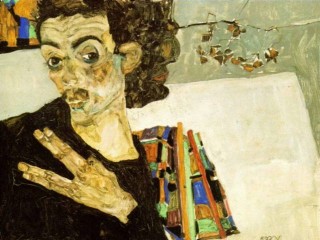
Egon Schiele biography
Date of birth : 1890-06-12
Date of death : 1918-10-31
Birthplace : Tulln an der Donau, Austria
Nationality : Austrian
Category : Arts and Entertainment
Last modified : 2011-03-08
Credited as : Artist painter, Expressionist , Death and the Maiden
Egon Schiele was an Austrian Expressionist painter and draftsman, whose reputation increased greatly through the years.
Egon Schiele was born in 1890 in Lower Austria as the third child in his family. His father was a rail-road civil servant who died in 1905. His uncle became his guardian but did not support his artistic career. Nevertheless, Schiele entered the academy in Vienna where he quickly ran into difficulties with his teacher, the then famous Professor Griepenkerl.
In 1907 he met Gustav Klimt, whom he admired, who assisted him in obtaining his first commissions and who influenced his early drawing style. Following Klimt's suggestion, Schiele entered four paintings in the Vienna International Exhibition of 1909, where works by Oskar Kokoschka and Vincent Van Gogh were also shown. In the same year he left the academy and, with other young artists, formed the short-lived artist group "Neukunstgruppe"; however, the first exhibition was not successful. By 1910 he had found his own style with its strong emphasis on the contour line and vibrant colors.
In 1911 he moved to the small town of Krumau, where he painted a number of townscapes. His lifestyle caused problems in the town and he moved with his model Wally Neuziel to Neulengbach where in 1912 he was arrested and charged with immorality and seduction. Some of his drawings were confiscated; one was even burned by the judge in the courtroom. He spent 24 traumatic days in jail and returned to Vienna upon his release.
His first important exhibitions were held in Germany: in 1913 in the famous Galerie Goltz in Munich and in the Folkwangmuseum in Hagen, followed by one-man exhibits in Hamburg, Breslau, Stuttgart, and Berlin, where the Expressionist journal Die Aktion published his drawings as well as his poetry. In 1915 he married Edith Harms, and a few days later he was drafted into the army. After having been assigned to guard Russian prisoners of war, the Die Aktion journal published a special issue with his drawings and the Berlin Sezession exhibited his works.
In 1917 he was transferred to the Army Museum in Vienna, which provided him with some time to paint again. A portfolio of 12 drawing reproductions was published. He was invited to participate in exhibits in Munich, Dresden, Amsterdam, and Stockholm, but his poverty remained unchanged. The first truly great success came in 1918 with his exhibit at the Vienna Secession (no less than 19 paintings and several drawings). He received a number of commissions, and 25 of his works were exhibited in Zurich. Shortly thereafter, however, his wife—who was expecting a child-died of the Spanish influenza epidemic, and three days later the artist succumbed to the same disease.
Schiele was an extraordinary artist who—together with the young Kokoschka—must be considered the outstanding Austrian Expressionist. His dominating theme was the human body, which he depicts in truly singular forms. The many nudes, female as well as male, are devoid of any then-acceptable concept of beauty and are like psychograms emphasizing tensions and even tragedy. Likewise in his paintings of children he emphasized their awkward bodies and their earnest eyes, and yet, the impact of these works on the viewer is very strong because the depictions are forthright and direct. His eros knows more of unresolved tensions and painful dreamstates than of joy. Even his marvelous townscapes frequently lack perspective dimensions and let the windows of the houses appear like blind eyes; they are expressions of the artist's mood more than topographical depictions; they are images of fall—with isolated, dry trees standing in the cold wind.
Schiele's symbolic works, such as "Death and the Maiden," "The Hermits," or even such seemingly happy themes as "Mother with Two Children," show the same penetrating insight for which his portraits have become famous, giving less a literary likeness than a psychogram of the sitters and subjects. His many self-portraits are proof of his continuous struggle with what he considered the soul of the arts: the depiction of that truth which lies below the surface. While the subject matter seems to be depressing, his works prove otherwise. The extraordinary ability to form the three dimensional body through dominating contour lines, his choice of very strong and forthright colors, the frequently ambiguous spaces, and his extraordinary sensitivity, which transforms even a seemingly quick drawing into a complete work of art, have allowed Schiele's fame to continue to grow. The feverish erotic states which so frequently dominate Schiele's works have by now lost their shock and have been recognized as unique depictions of human life as seen by one of the great artists of the 20th century.
The oeuvre catalogues of Schiele's works (paintings as well as graphics) have been published by Otto Kallir-Nirenstein (1966; 1970). To these can now be added the 1973 volume by Rudolf Leopold. Arthur Roessler published Schiele's letters and prosepoems in 1921, and Christian M. Nebehay in 1979 published a biography together with many newly discovered letters and some of the poems. Special aspects of Schiele's life and works have been treated by contemporaries, such as Heinrich Benesch in My Way with E.S. (1965), and Alexandra Comini wrote a monograph on Schiele's portraits and a number of important articles. Of equal importance are the many exhibition catalogues, which not only attest to the artist's growing fame but frequently contain important critical contributions.
















